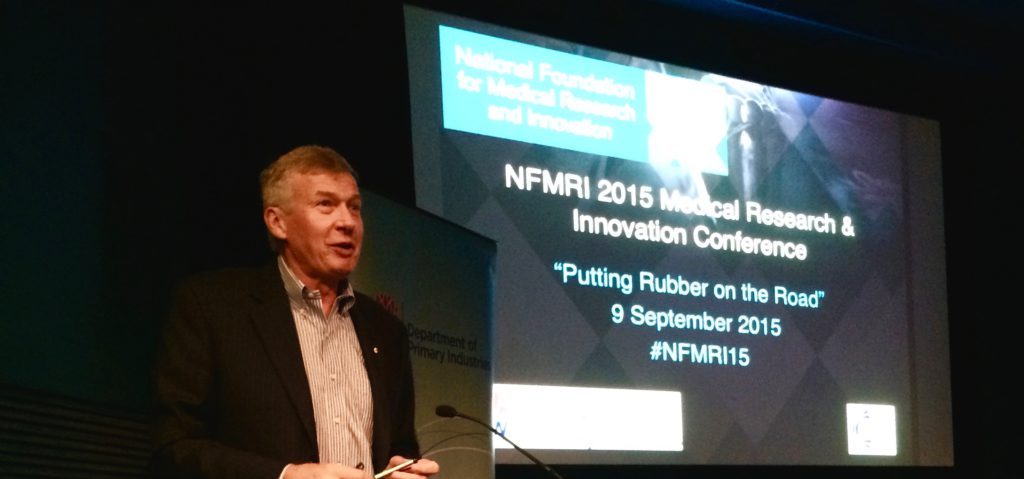A few weeks ago, we held our inaugural medical research and innovation conference, “Putting Rubber on the Road”, in Sydney. The conference was launched by Mr Paul Clitheroe AM, who coined this title when we introduced and discussed the role, strategy and approach of our Foundation.
The concept of our inaugural conference came about after noticing a strong need for discussion around the benefits of advancing Australian innovations. Research indicates that despite Australia investing plenty of resources in research, that uptake from industry remains quite poor. We felt there was an opportunity to bring various stakeholders together in one room to discuss why this was the case and importantly what could be done to improve this.
Leaders from industry, government, venture capital, academia, philanthropy and research convened to discuss the challenges facing the medical research and innovation sector, and to highlight the opportunities and steps we can take to move Australia forward in the right direction. Some of the key issues that were raised by speakers and delegates related predominantly around the need for cultural change.
There were many opportunities raised over both days, including:
1. Opportunity to revamp rewards systems
Systems and cultures that lack balance and incentivise academics based on publications only, and not on social impact or industry engagement have a negative influence on delivering community benefits. Universities that have managed to get over this hurdle such as Imperial College London and Cornell Tech in New York are experiencing success.
2. Opportunity to strengthen university engagement offices
Industry engagement offices that are responsible for external collaborations and commercialisation are often under resourced, lack responsibility, funds and project management skills to meet the deadlines and expectations of industry partners.
3. Ensuring that researchers who commercialise aren’t disadvantaged
Early career researchers who want to create impact and commercialise their research may put their careers at risk. The decision to translate and commercialise often comes at the expense of NHMRC grants and future career growth within universities as a result of producing less (or delayed) publications.
4. Opportunity for universities to provide new career pathways that cater for the jobs of tomorrow
Alternative career pathways for PhD students was also raised as an issue as the students are being trained for academic careers that don’t exist and other skills are not accessible or considered of value. By adapting programs to provide more wide-ranging as well as targeted training, students are more likely to secure employment in the long run. Encouraging students to transition from academia to industry (and back) will provide these students with better understanding of the research ecosystem and could make them more sought after.
5. Opportunity for funders of research, universities, industry as well as government to develop and adopt the same data classification system
At the moment the definitions and classification of grants is not entirely consistent and this leads to unreliable data – and data that is not as useful as it could be. Developing and adopting a universal classification system and definitions would lead to more reliable data and metrics to so that everyone can better understand opportunities, successes and issues.
6. Opportunity to build a strong reputation as a partner of choice
Helping innovations to move further along the research chain can help attract better partners that are capable of value-adding and are more likely to deliver a benefit.
7. The need for a stable policy platform, both at the state and federal level.
Let’s put this one on our Christmas wish list!
8. Opportunity to up skill researchers in commercialisation
More support, access and promotion of options for academic researchers wishing to learn about translation, commercialisation and to develop skills that will enable them to work with industry.
9. Opportunity to learn from leading overseas universities to improve engagement
There was some discussion around how universities such as Harvard and Oxford had successfully developed alumni networks and were heavily involved in long-term engagement. The opportunity for Australian universities to better engage with their local and global alumni and keep track of them as they progress through their careers was discussed. It was noted that engagement comes at a cost (events and functions, activities etc), but building a community amongst alumni would help develop university loyalty and eventually support.
It was clear that there is an opportunity for NFMRI to work with other stakeholders and together take a leadership role to voice concerns to policy makers. This also includes working with the Medical Research Future Fund to help ensure there is future support for translation and commercialisation.
It was emphasized at the conference that translation and commercialisation should not be seen as a replacement for blue-sky research, but merely a next step for those projects that are able to advance via this pathway.
There were comments made around how funders of research were in a unique position to help lead this cultural change, as universities were likely to change to meet the requirements of funding conditions. One gentleman told a story about how he recently visited his old university campus. Over 20 years on, the same lecture in the same hall was taking place. Nothing had changed.
We are very much interested in your ideas, suggestions or comments on how you think this can be achieved. Please leave a comment below or contact us via email

